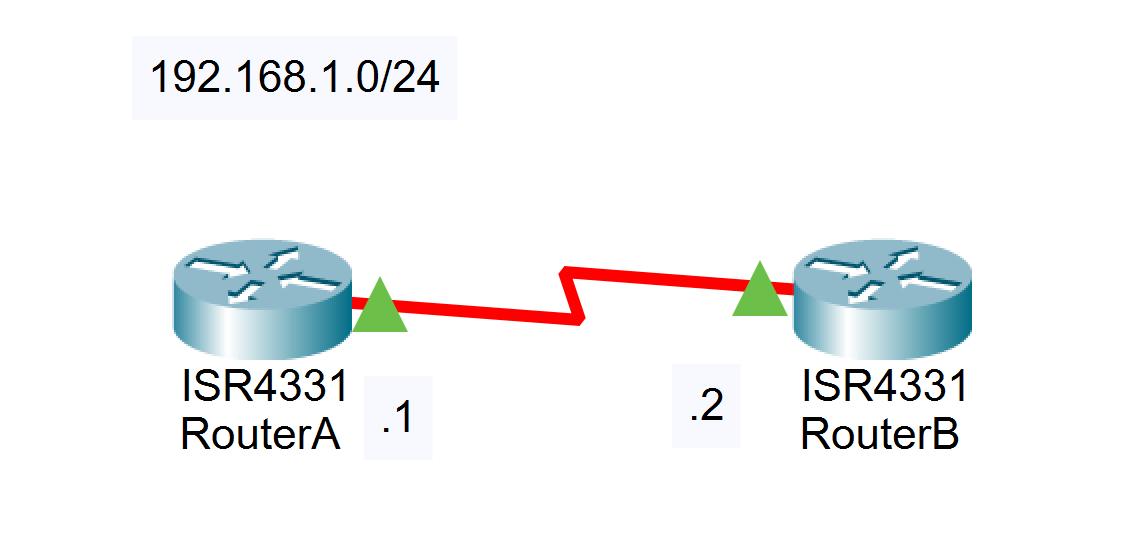# 10:PPP 验证实验
点此下载本次实验的 Cisco Packet Tracer 文件
# 实验要求
本次实验主要完成以下两项操作:
PAP验证
为路由器指定唯一主机名,为了辨别设备,需要设置不同的主机名。
列出认证路由器时所使用的远程主机名称和口令,PAP为单项验证,所以被验证方需要正确的主机名和口令,方能使链路通畅。
WAN接口上完成PPP协议的封装。PAP验证基于PPP协议,必须封装后才能启用。
RouterA为服务端,RouterB为客户端,客户端主动向服务端发出认证请求,密码设置为ccna。
CHAP 验证
为路由器指定唯一主机名,为了辨别设备,需要设置不同的主机名
列出认证路由器时所使用的远端主机名称和口令,密码为ccna。CHAP 为双向验证,通过将对方发送的用户名和口令与本地的用户列表来对比确认。一致通过,不一致链路阻塞。WAN接口上完成PPP 协议的封装和CHAP 认证的配置PAP 验证基于PPP 协议,必须封装后才能启用。
# 实验拓扑

# 实验过程
# PAP验证
# 1 配置RouterA的服务端设置
RouterA(config)#username nju password ccna
RouterA(config)#interface s0/1/0
RouterA(config-if)#ip address 192.168.1.1 255.255.255.0
RouterA(config-if)#encapsulation ppp
RouterA(config-if)#ppp authentication pap
RouterA(config-if)#no shutdown
1
2
3
4
5
6
2
3
4
5
6
# 2 配置RouterB的客户端设置
RouterB(config)#interface s0/1/0
RouterB(config-if)#ip address 192.168.1.2 255.255.255.0
RouterB(config-if)#encapsulation ppp
RouterB(config-if)#no shutdown
1
2
3
4
2
3
4
# 3 client 端发送用户名和密码
RouterB(config-if)#ppp pap sent-username adsf password adsf
1
注:当用户名和口令中的任意一个和验证方的本地用户列表不同时,无法通信。
RouterB#ping 192.168.1.1
Type escape sequence to abort.
Sending 5, 100-byte ICMP Echos to 192.168.1.1, timeout is 2 seconds:
.....
Success rate is 0 percent (0/5)
1
2
3
4
5
2
3
4
5
# 4 设置正确的用户名和密码
RouterB(config-if)#ppp pap sent-username nju password ccna
RouterB(config-if)#end
RouterB#ping 192.168.1.1
1
2
3
2
3
测试结果如下。
Type escape sequence to abort.
Sending 5, 100-byte ICMP Echos to 192.168.1.1, timeout is 2 seconds:
!!!!!
Success rate is 100 percent (5/5), round-trip min/avg/max = 28/28/32 ms
1
2
3
4
2
3
4
# CHAP 验证
# 1 配置RouterA
RouterA(config)#username nju2 password ccna
RouterA(config)#interface s0/1/0
RouterA(config-if)#ip address 192.168.1.1 255.255.255.0
RouterA(config-if)#encapsulation ppp
RouterA(config-if)#ppp authentication chap
RouterA(config-if)#no shutdown
1
2
3
4
5
6
2
3
4
5
6
# 2 配置RouterB
RouterB(config)#int s0/1/0
RouterB(config-if)#ip address 192.168.1.2 255.255.255.0
RouterB(config-if)#encapsulation ppp
RouterB(config-if)#ppp authentication chap
RouterB(config-if)#no shutdown
1
2
3
4
5
2
3
4
5
注:对端需要配置相同,因为chap 是双向认证,由于一端没有发送本地用户名和列表,导致链路不通。
# 3 设置RouterB 上的用户名和密码
RouterB(config)#username nju1 password ccnp
RouterB#ping 192.168.1.1
1
2
2
测试结果如下。
Type escape sequence to abort.
Sending 5, 100-byte ICMP Echos to 192.168.1.1, timeout is 2 seconds:
.....
Success rate is 0 percent (0/5)
1
2
3
4
2
3
4
# 4 设置正确的用户名和密码
RouterB(config)#username nju1 password ccna
RouterB#ping 192.168.1.1
1
2
2
测试结果如下。
Type escape sequence to abort.
Sending 5, 100-byte ICMP Echos to 192.168.1.1, timeout is 2 seconds:
!!!!!
Success rate is 100 percent (5/5), round-trip min/avg/max = 28/28/32 ms
1
2
3
4
2
3
4
在验证通过的情况下,将任意一边的口令随意设置成一个非ccna 的口令,再测试连通性。
RouterB(config)#username RouterA password ccnp
RouterB#ping 192.168.1.1
1
2
2
测试结果如下。
Type escape sequence to abort.
Sending 5, 100-byte ICMP Echos to 192.168.1.1, timeout is 2 seconds:
!!!!!
Success rate is 100 percent (5/5), round-trip min/avg/max = 28/28/32 ms
1
2
3
4
2
3
4
注:因为当验证通过后会一直保存已经建立好的连接,解决方法是将接口关闭在启动。
# 实验命令列表
| 启用PPP封装协议 | encapsulation ppp |
|---|---|
| 启用PAP身份验证 | ppp authentication pap |
| 设置被验证发送的用户名和口令 | ppp pap sent-username [用户名] password [密码] |
| 启用CHAP认证协议 | ppp authentication chap |